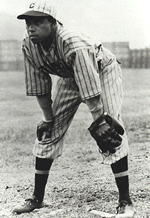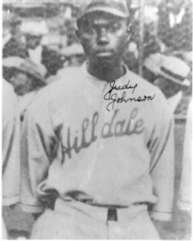|
 WILLIAM “JUDY" JOHNSON WILLIAM “JUDY" JOHNSON
Position: Third Baseman, 1918-1937
Height: 5' 11"
Weight: 150 lbs.
B/T: Right, Right
Born: 1899 in Snow Hill, MD
Died: 1989 in Wilmington, DE
Hall of Fame Induction: 1975
The ultimate clutch-hitter, Judy Johnson shamelessly indulged in game-winning hits and rally-killing catches. Johnson was a bashful, quiet performer with an astonishing ability to perform under pressure. He was respected for his intellectual approach to the game, excelling with grace and poise; providing a positive influence on teammates and opponents.
Ted Page, a former outfielder for the Crawfords, bragged, "Judy Johnson was the smartest third baseman I ever came across. A scientific ball player, he did everything with grace and poise. You talk about playing third base? Heck, he was better than anybody I saw. And I saw Brooks Robinson, Mike Schmidt and even Pie Traynor. He had a powerful, accurate arm. He could do anything, come in for a ball, cut if off at the line, or range way over toward the shortstop hole. He was really something."
In his first pro season of 1918, he played behind Bill Francis at third, hitting a modest .227. Johnson credits John Henry "Pop" Lloyd with his early development. "He's the man I gave the credit to for polishing my skills," Johnson recalled. "He taught me how to play third base and how to protect myself. John taught me more baseball than anyone else." The well-schooled disciple of "Pop" developed into a full-time star leading the Hilldales to their first Eastern Colored League pennant, in 1923, with a .391 average.
The following season, Hilldale, behind Johnson's .324 average, hosted the Kansas City Monarchs in the first official Colored World Series. Johnson led all batters, hitting .364, and slugging out a .614 average. He led the series in RBIs (8), hits (16) and added an inside-the-park home run in a thrilling nine-game series loss to the Monarchs.

Johnson continued to punch in over .300 every season until he suffered a cranial beaning in August 1926, playing in Atlantic City. Cloaked with a lack of confidence, he slumped to .268 (1927) and .224 (1928). In 1929, Johnson shook off the wraps and proceeded to hit a hefty .390. This prompted sportswriter Rollo Wilson of the Pittsburgh Courier to name Johnson the league's Most Valuable Player.
After such a great comeback, Johnson's services were in much demand. With many teams in the early Thirties struggling with the economics of the Great Depression, Johnson bounced from the Hilldales to the Grays, back to the Darby Daisies, to the Grays before finishing the 1932 with the Crawfords.
In 1935, the Crawfords named Judy Johnson captain of their team over such stellar stars as Paige, Gibson, and Bell. This star-studded team managed by Oscar Charleston, won 39 games and lost 15, defeating the New York Cubans and Luis Tiant, Sr., in a seven-game series for the Negro National League pennant.
Cool Papa Bell once bragged: "Johnson was the best hitter among the four top third basemen in the Negro Leagues, but no one would drive in as many clutch runs as he would. He was a solid ballplayer, real smart, but he was the kind of fellow who could 'just get it done.' He was dependable, quiet, not flashy at all, but could handle anything that came up. No matter how much the pressure, no matter how important the play or the throw or the hit, Judy could do it when it counted."
A notorious clutch hitter, Judy could get hits like a chain smoker, lighting one hit on the butt of one after another. Calm when it came to sweaty palm heroics, Judy had the blasting power to pull off heroic feats and the baseball smarts to avoid laboring.
|